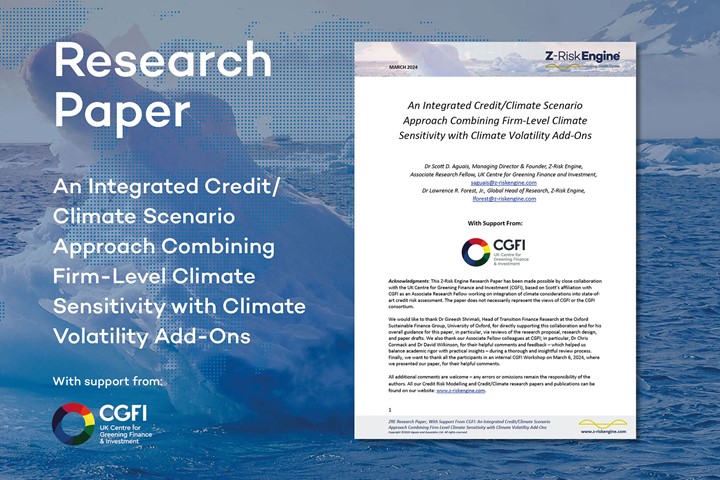
Articles, Climate Risk
25 Mar 24
Research Paper with support from CGFI
An Integrated Credit/Climate Scenario Approach Combining Firm-Level Climate Sensitivity with Climate Volatility Add-Ons
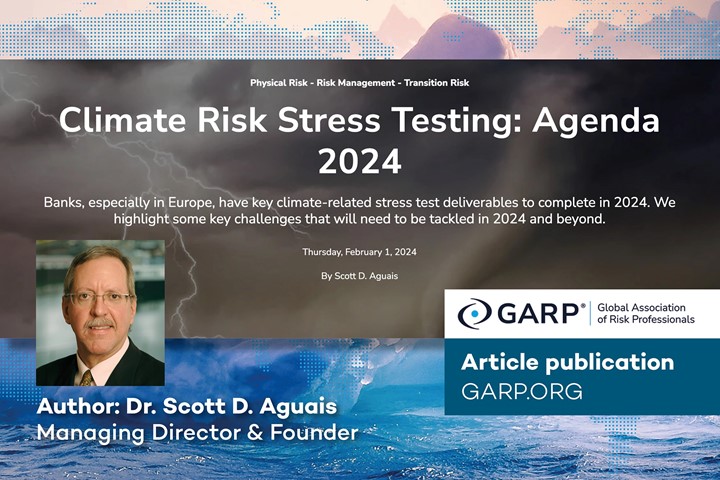
Articles, Climate Risk
1 Feb 24
Our latest Climate article for GARP is published
Based on our long-term experience building and implementing credit models E2E, we list four ideas for bank’s Climate Risk Stress Testing agenda for 2024 and beyond.
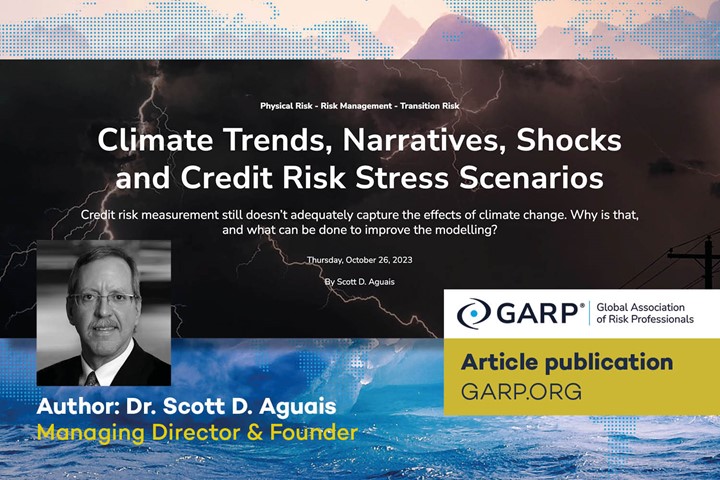
Articles, Climate Risk
26 Oct 23
GARP Sustainability & Climate article
Today our Sustainability & Climate article was published on GARP: ‘Climate Trends, Narratives, Shocks and Climate Stress Scenarios’.
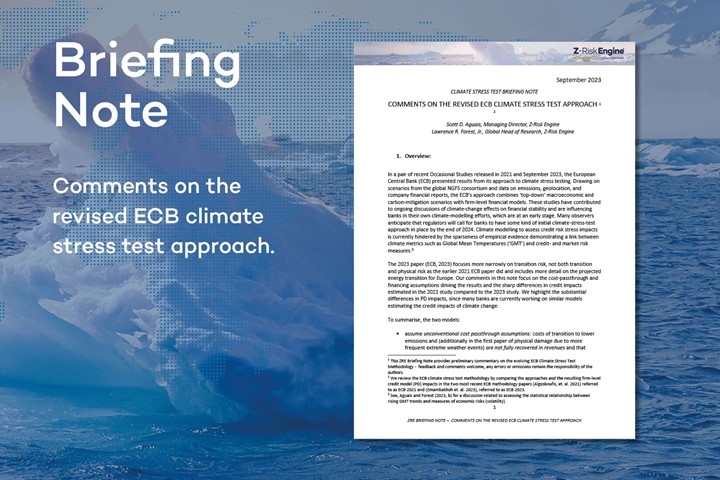
Articles, Climate Risk
16 Oct 23
Climate Stress Test Briefing Note
This briefing note takes us through comments on the revised ECB climate stress test approach.
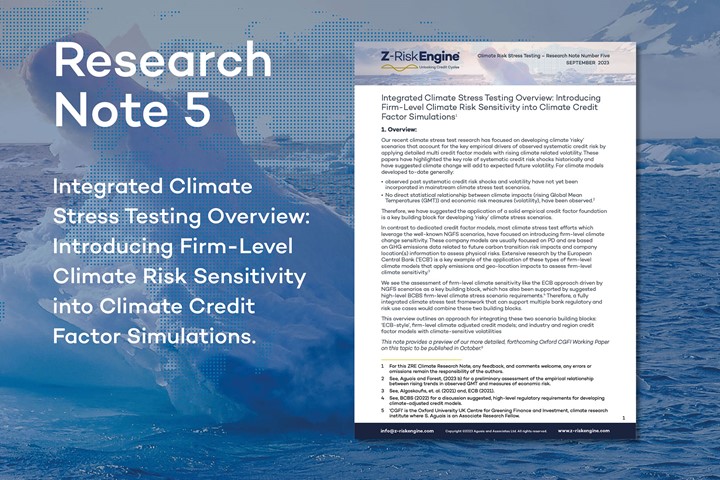
Articles, Climate Risk
18 Sep 23
Climate Risk Stress Testing Research Note 5
This papers takes us through Introducing Firm-Level Climate Risk Sensitivity into Climate Credit Factor Simulations.
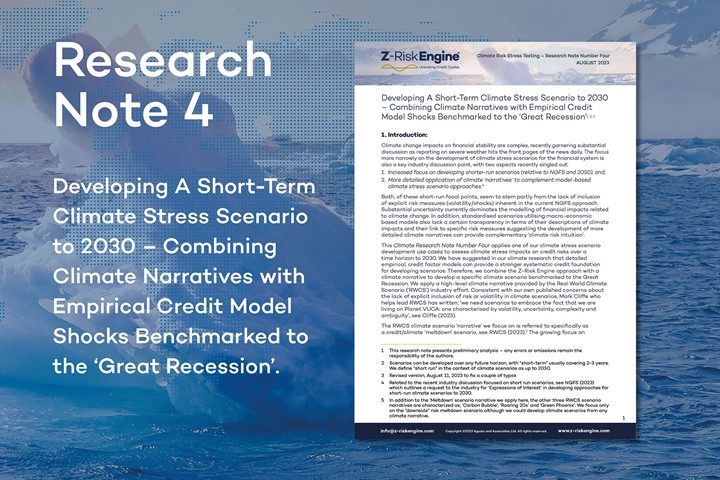
Articles, Climate Risk
16 Aug 23
Climate Risk Stress Testing Research Note 4
This papers takes us through Developing A Short-Term Climate Stress Scenario to 2030 – Combining Climate Narratives with Empirical Credit Model Shocks Benchmarked to the ‘Great Recession’.
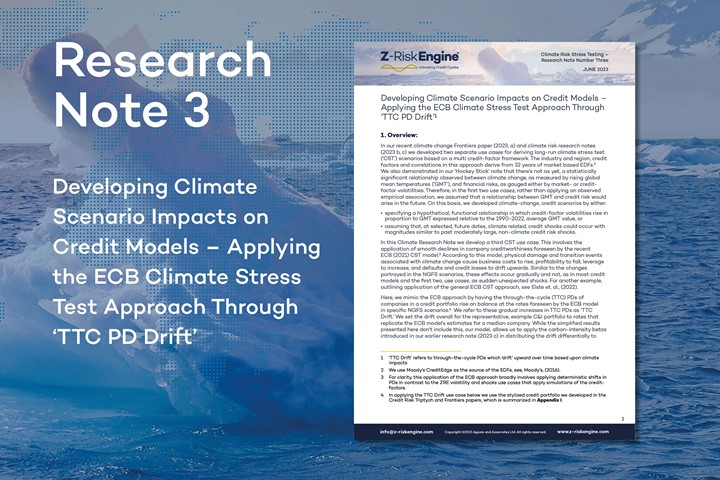
Articles, Climate Risk
5 Jun 23
Climate Risk Stress Testing
This papers takes us through Developing Climate Scenario Impacts on Credit Models – Applying the ECB Climate Stress Test Approach Through ‘TTC PD Drift’
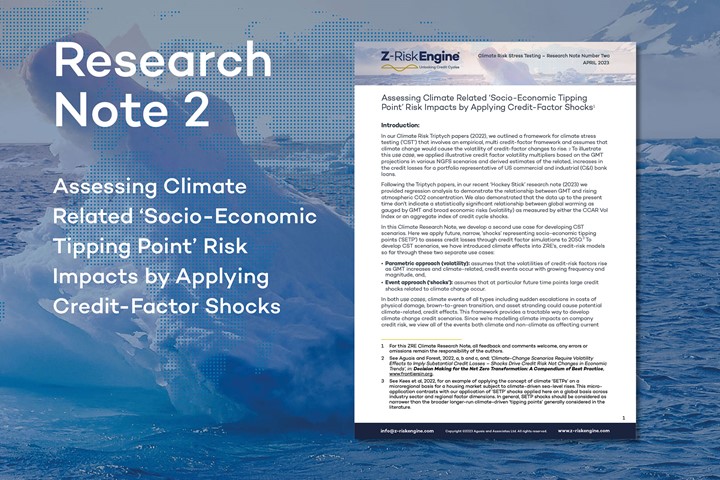
Articles, Climate Risk
17 Apr 23
Climate Risk Stress Testing – Research Note Number Two
This research note assesses a second climate use case for developing long-run climate scenarios, in this case for potential, narrow ‘socio-economic tipping point’ (‘SETP’) shocks.
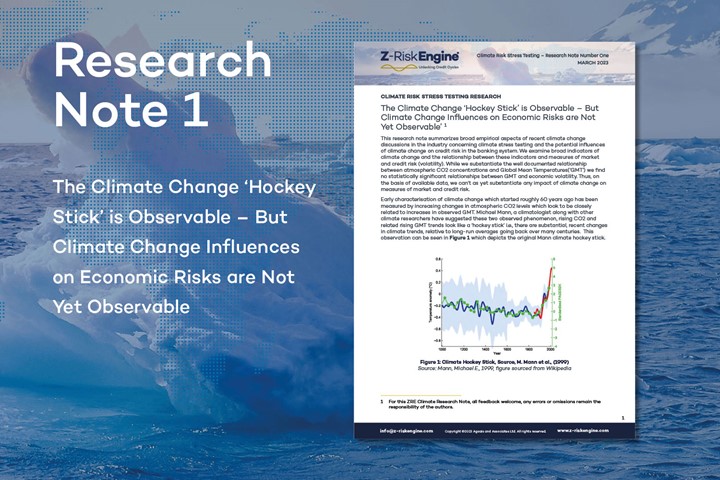
Articles, Climate Risk
15 Mar 23
Climate Risk Stress Testing – Research Note Number One
This research note summarizes broad empirical aspects of recent climate change discussions in the industry concerning climate stress testing and the potential influences of climate change on credit risk in the banking system.
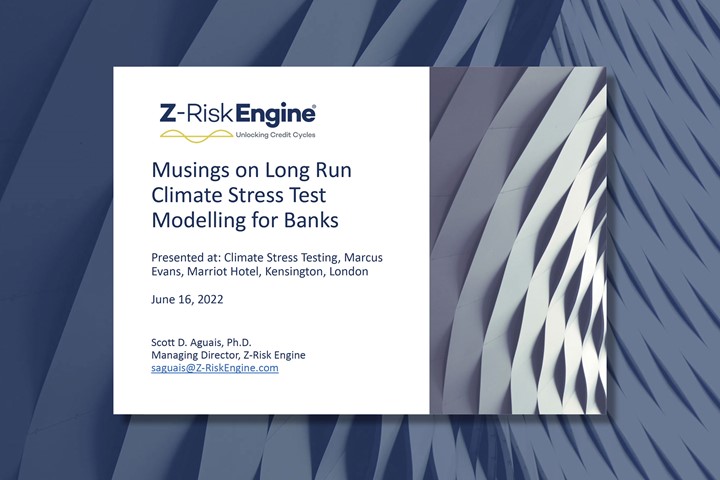
Articles
21 Jun 22
Presentation from the Marcus Evans Climate Risk And Stress Testing Conference
Our presentation ‘Musings on Long Run Climate Stress Test Modelling for Banks’ from last week’s Marcus Evans' Climate Risk And Stress Testing Conference.
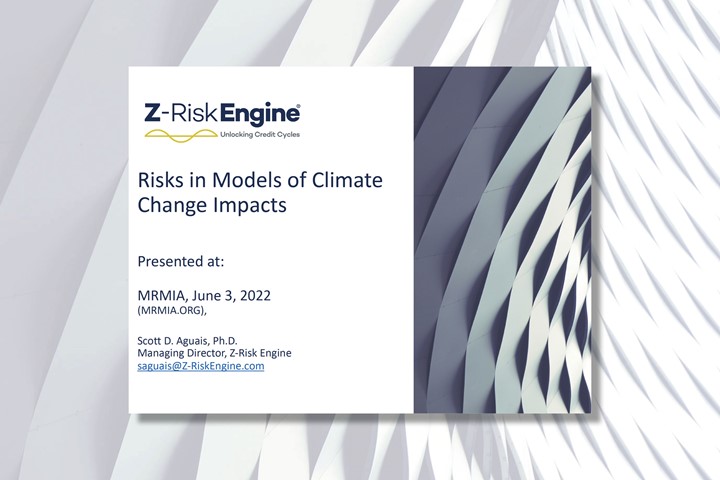
Articles
6 Jun 22
Presentation from the 2nd MRMIA Best Practices Virtual Summit
Our recent presentation from the MRMIA conference, ‘Risks in Models of Climate Change Impacts’, discussing stress testing and modelling approaches for dealing with Uncertainty vs Risk for climate models developed to project future climate impacts when general uncertainty is high.

Articles, Climate Risk
3 May 22
Presentation from the ESG Europe Conference in London, April 2022
Presentation by Dr Scott D. Aguais titled 'Musings on Long Run Climate Risk Modelling for Banks'.
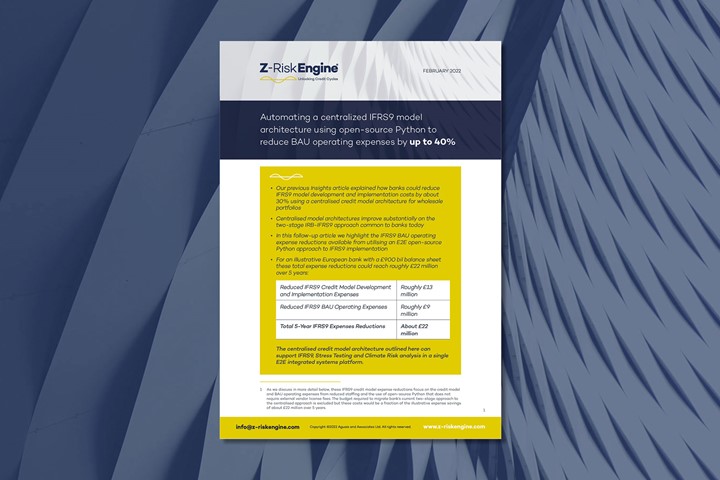
Articles
15 Feb 22
Using a centralized IFRS9 model architecture and Python to reduce BAU operating expenses by up to 40%
In this follow-up article we highlight the IFRS9 BAU operating expense reductions available from utilising an E2E open-source Python approach to IFRS9 implementation
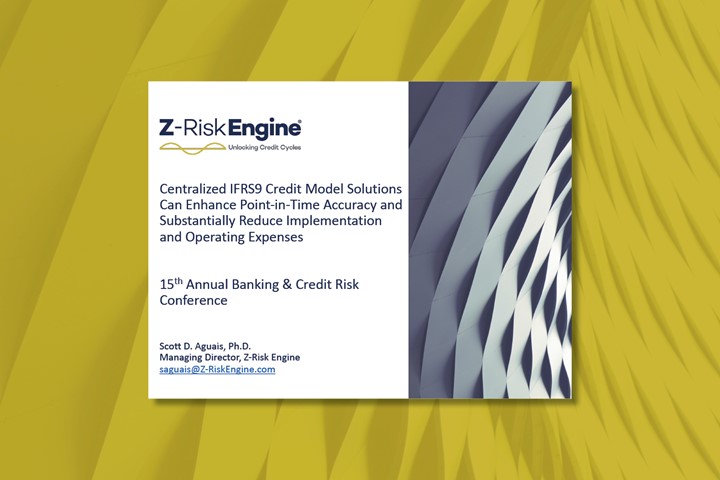
Articles
7 Feb 22
Presentation from the 15th Annual Banking & Credit Risk Conference
Centralized IFRS9 Credit Model Solutions Can Enhance Point-in-Time Accuracy and Substantially Reduce Implementation and Operating Expenses
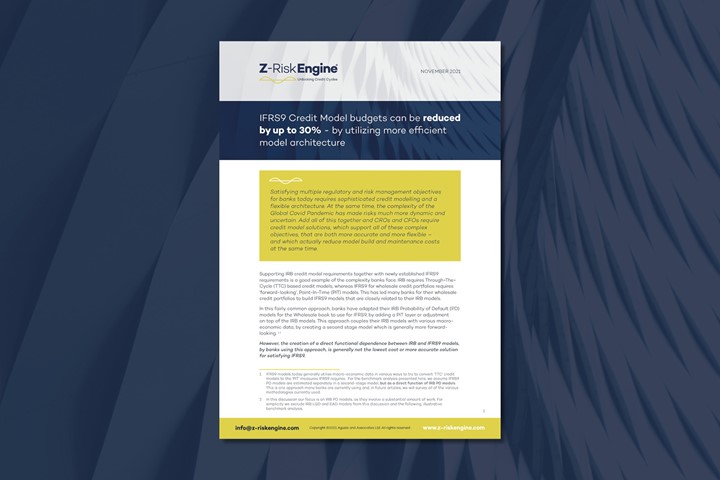
Articles
29 Nov 21
IFRS9 Credit Model budgets can be reduced by up to 30%
We calculate in an illustrative benchmark exercise described in this article, that banks could save up to 30% of their credit model operating budgets by utilizing a single, holistic IFRS9 model architecture.
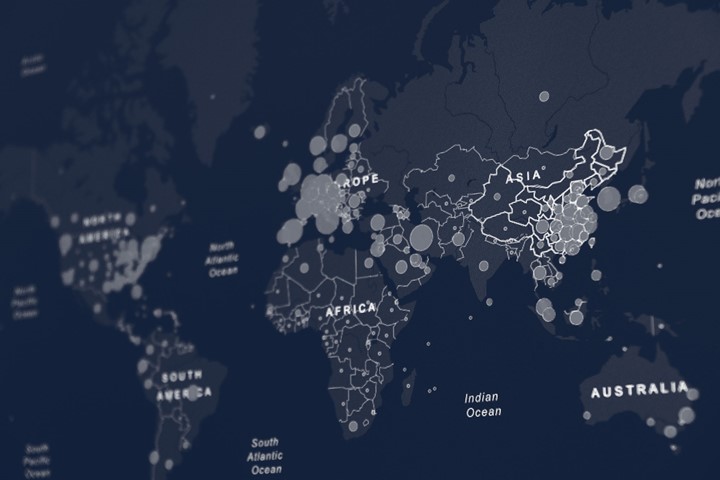
Articles
23 Mar 20
ZRE Coronavirus PIT ECL Impact Analysis 23-MAR-20
Indirect effects on a US/UK hypothetical credit portfolio as of March 23, 2020

Articles
16 Mar 20
ZRE Coronavirus PIT ECL Impact Analysis 16-MAR-20
Indirect Effects on a US/UK Hypothetical Credit Portfolio as of March 16, 2020
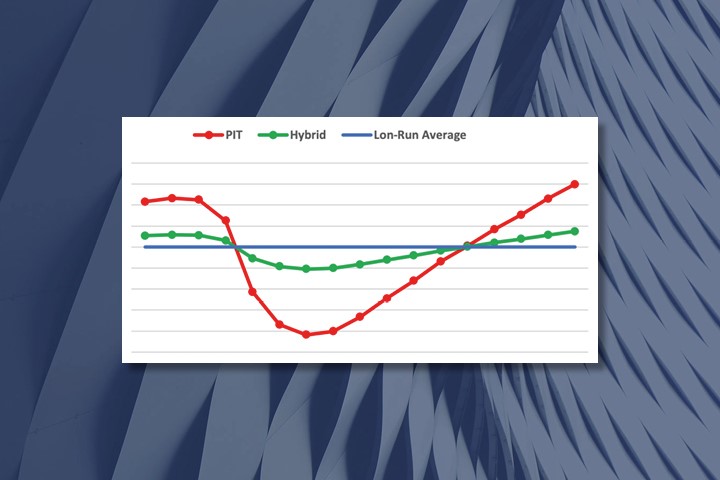
Articles
17 Sep 19
Inaccuracies Caused by Hybrid Credit Factors
Explaining the way in which hybrid models differ from PIT ones and presenting evidence that many banks are struggling with PIT estimates which are extremely important for accurate IFRS9/CECL and Stress Test assessments.
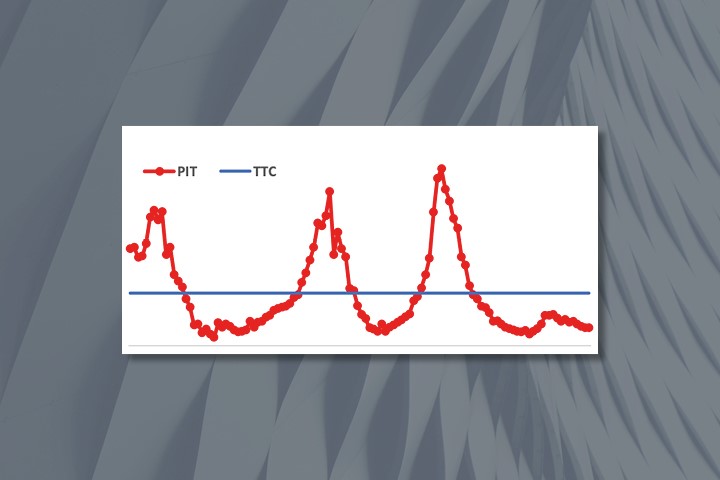
Articles
5 Jun 19
Stress Understatement Using GDP Drivers
To obtain accurate estimates of cyclical variations in credit losses, banks must include fully PIT, market-value-related, risk factors as drivers. Otherwise, the results would understate intertemporal variations related to the credit cycle.
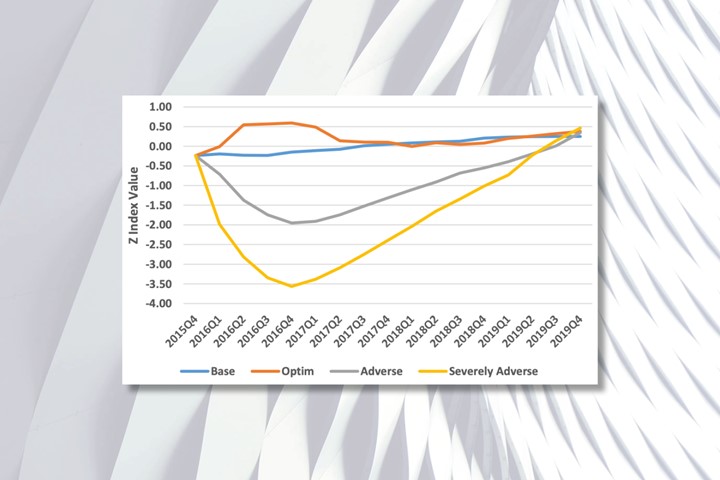
Articles
11 Apr 19
Variance Compression Bias in Expected Credit Loss Estimates Derived from Stress-Test Macroeconomic Scenarios
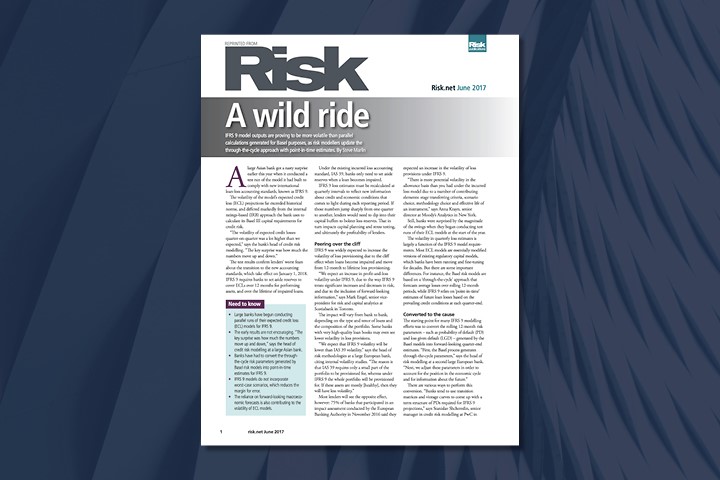
Articles
28 Jun 17
Risk.net Article
In this Risk.net article on the potential volatility of IFRS9 loss projections where Z-Risk Engine (ZRE) MD, Dr Scott D. Aguais provides key commentary and explanation on how the ZRE solution is well placed to meet these new challenges.

Articles
24 Apr 17
Comments in response
Comments in response to “A point-in-time–through-the-cycle approach to rating assignment and probability of default calibration”
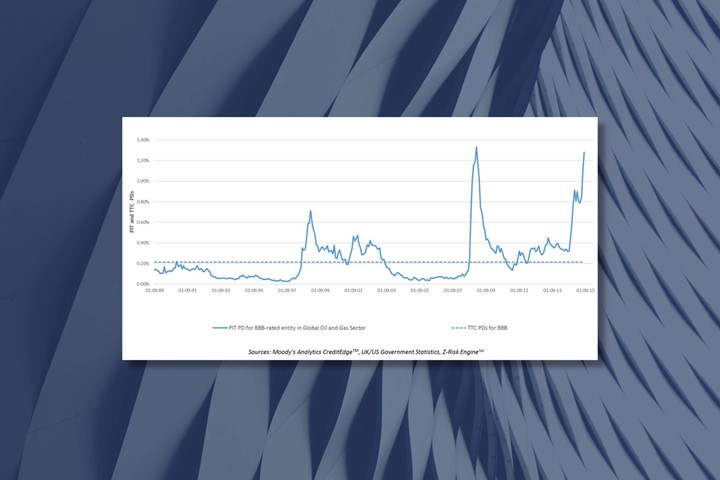
Articles
22 Sep 16
Some options for modelling Significant Deterioration in IFRS9
In this study, we model IFRS9 Significant Deterioration from an end-to-end perspective covering topics such as PIT PD term structure, data based triggers, trigger design, threshold levels and implementation.
Final version published in Journal of Risk Model Validation, Q3 2016 edition.

Articles
11 Aug 16
Risk.net Article
Article about Z-Risk Engine developers titled 'The new A to Z of risk modelling' published in the August edition of Risk magazine, describing the evolution of the PIT/TTC framework and the journey taken by Z-Risk Engine developers.

Articles
28 Jun 16
Convexity and Correlation Effects in Expected Credit Loss calculations for IFRS9/CECL and Stress Testing
In this study, we demonstrate that the convexity of PD functions together with correlation among PD, LGD, and EAD outcomes impart skewness to the credit-loss, probability distribution function (PDF) and increase the expected credit losses (ECLs) by as much as 20% or more.
This article will be published in Journal of Risk Management in Financial Institutions (JRMFI) Volume 9 / Number 4 / Autumn, 2016

Articles
22 Mar 16
Point in Time LGD and EAD models for IFRS/CECL and Stress Testing
In this journal article, we offer options for formulation of PIT LGD and EAD models, and show that, by accounting for the probabilistic evolution over time in industry-region credit-cycle indices, one can derive joint, PD, LGD, EAD scenarios for use in IFRS9/CECL and Stress Testing. Contact us for the final published article.

Articles
17 Jun 15
Biased Benchmarks
In this journal article, we show evidence that indicates that benchmarks like agency ratings have over the last 11 years, been exaggerating default risk for corporate entities. Contact us for the final published article.

Articles
15 Jul 13
Comment in response
Comment in response to "A methodology for point-in-time–through-the-cycle probability of default decomposition in risk classification systems". In this journal article, we critique Carlehed and Petrov's PIT/TTC methodology and refute some of their claims. Contact us for the final published article.

Articles
23 Jan 07
Designing and Implementing a Basel 2 Compliant PIT-TTC Ratings Framework
This journal article provides the foundation of PIT-TTC Ratings framework.

Articles
28 Oct 04
Point-in-Time versus Through-the-Cycle Ratings
This journal article provides the foundation of PIT-TTC Ratings framework.

Articles
11 Dec 01
Enterprise Credit Risk Management
This journal article motivates the development of a framework for integrating credit risk and reward across the enterprise and describes its necessary components.

Articles
18 Apr 01
Implementing a Comprehensive Credit-Risk-Management System - The Case of Hanvit Bank
This journal article describes development and implementation of the key credit-risk analytic applications at Hanvit Bank.

Articles
14 Dec 00
Building a Credit Risk Valuation Framework for Loan Intruments
This journal article presents a general option-valuation framework for loans that provides valuation information at loan origination and supports mark-to-market analysis, portfolio credit risk and asset and liability management for the entire portfolio.

Articles
23 Nov 98
A one parameter representation of credit risk and transition matrices
This journal article presents a one-parameter representation of credit risk and transition matrices.

Articles
20 Oct 98
Expect the unexpected
In this journal article, we develop a direct approach to measuring credit risk at the transaction level.

Articles
17 Jun 98
Improving Quantification of Risk-Adjusted Performance Within Financial Institutions
This journal article demonstrates ways to improve quantification of risk-adjusted performance within financial institutions

Articles
18 Mar 98
Creating Value From Both Loan Structure and Price
Shrewd pricing and structuring of loans can enable a bank to satisfy customers’ needs while meeting its own risk/return requirements. This journal article describes a pricing method that uses net-present-value analysis to examine trade-offs between price and structure.

Articles
4 Mar 98
The effect of systematic credit risk on loan portfolios and loan pricing
In this journal article, we discuss the effect of systematic credit risk on loan portfolios and loan pricing by treating correlations as arising from a single systematic risk factor.

Articles
10 Feb 98
Incorporating New Fixed Income Approaches Into Commercial Loan Valuation
Accurate loan pricing has never been more complex than it is today and it has never been more critical to price accurately. This journal article discusses differences between some traditional and more sophisticated methodologies.